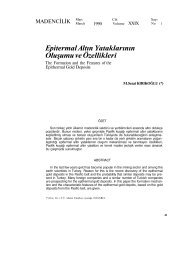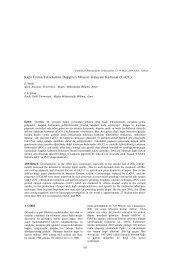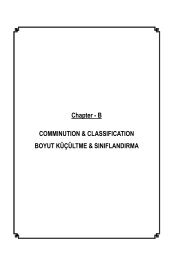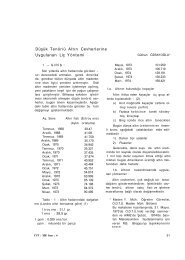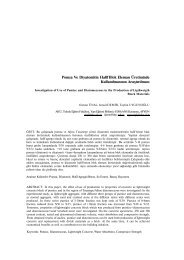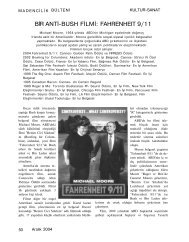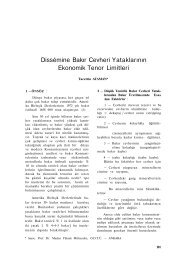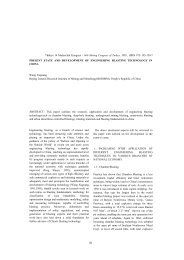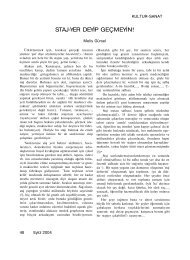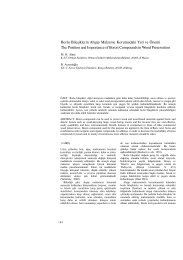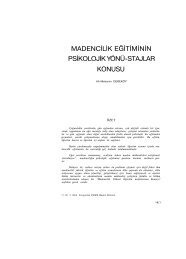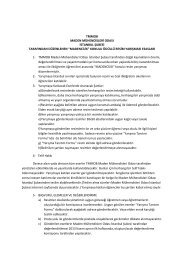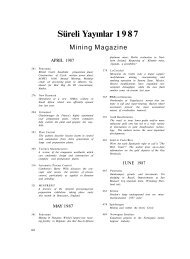A OPEN PIT MINING AÇIK OCAK MADENCİLİĞİ
A OPEN PIT MINING AÇIK OCAK MADENCİLİĞİ
A OPEN PIT MINING AÇIK OCAK MADENCİLİĞİ
You also want an ePaper? Increase the reach of your titles
YUMPU automatically turns print PDFs into web optimized ePapers that Google loves.
M. Coli, M. Baldi<br />
The granite was cut by means of lines of<br />
close spaced large wedge shaped holes into<br />
which were hammered iron wedges to split<br />
the rock into blocks Boulders and blocks<br />
were sized to the final shape, but not<br />
finished.<br />
4.3.3 - Use<br />
This granite was used by the Romans in the I<br />
and II centuries only for columns and pillars<br />
and for tiles, and can be found in Rome,<br />
Verona, Venice (St. Mark’s Basilica),<br />
Pompeii, Herculaneum, Leptis Magna,<br />
Apollonia, Tyre (Borghini, 1989; Lazzarini,<br />
2002).<br />
The buildings of the local settlements are<br />
made by cobblestone and small boulders<br />
(“collection and use”, Coli & Marino, 2008)<br />
of the local granite debris and regolite which<br />
were abundantly lying on the neighbouring<br />
ground. From our field observations it<br />
appears that this granite was used locally by<br />
the Romans/Byzantine for special structural<br />
purposes like bars, tiles, lintels, jambs.<br />
4.4 “Serpentina Muschinata”<br />
In a tributary of the Wadi Umm Esh, close to<br />
its confluence with the Wadi Atallah, the<br />
Romans opened a quarry in the local<br />
serpentine, the ornamental stone that is also<br />
known as “Marmo verde ranocchia” or Lapis<br />
Batrachites (Borghini, 1989; Lazzarini,<br />
2002)<br />
(http://www.musnaf.unisi.it/dettagliomarmi.<br />
asp?param=2&idnazione=5&id=1765).<br />
The Serpentina Moschinata was commonly<br />
used from the Predynastic period to the New<br />
Kingdom and perhaps was partially used<br />
during the Ptolemaic period, too (Aston et<br />
al., 2000).<br />
The Romans used this ornamental stone<br />
for tiles (Baia, Pompeii, Herculaneum,<br />
Rome, Leptis Magna, Cyrene, Cos) and for<br />
small statues (Borghini, 1989; Lazzarini,<br />
2002).<br />
4.4.1 - Geology<br />
This serpentine was part of the Ophiolite<br />
suite of the basement core complex. Two<br />
varieties of this serpentine were quarried<br />
(Aston et al., 2000): variety 1 is grayish to<br />
greenish with black veins or patches, it is<br />
mainly a fine grained antigorite with rare<br />
chrisotile, lizardite and scattered veins of<br />
dolomite, plus accessory minerals<br />
(magnetite, talc and tremolite). Variety 2 is<br />
mostly black and speckled with grey and<br />
brown grains with a matrix of antigorite in<br />
mesh structure with iron oxide grains<br />
resembling olivine crystals and scattered<br />
pseudomorphs of pyroxenes. Black veins of<br />
magnetite are particularly evident.<br />
4.4.2 - Quarrying<br />
Brown & Harrell (1995) report a partial<br />
destruction of the quarry due to a recent<br />
quarrying activity, but the scarce remains of<br />
Roman buildings are still present.<br />
5 SETTLEMENTS<br />
Along the whole Wadi Hammamat area there<br />
are remains of settlements connected with<br />
quarries and mines, the settlement housed<br />
the people and were also the places where<br />
the gold-ore was worked.<br />
Ruins of little settlements are close to the<br />
Bekhen-stone and “Serpentina Moschinata”<br />
quarries, ruins of several little settlements<br />
are preserved in the Wadi Atallah and Wadi<br />
el Sid, close to mine and quarry sites. The<br />
main settlement was Bir Umm Fawakhir<br />
(Meyer, 1997, 1998; Meyer et al., 2000,<br />
2011).<br />
According with Meyer (1997, 1998) these<br />
settlements housed about one thousand<br />
people in Byzantine times, mainly<br />
administrative staff and career miners with<br />
their entire families (Meyer et al., 2003).<br />
Generally speaking, we want to highlight<br />
that also in the most remote quarry sites of<br />
the Eastern Desert the Romans had a high<br />
living standard (Van der Veen, 1997; Meyer<br />
et al., 2003).<br />
The settlement buildings are reduced to a<br />
few basements of huts made up in stackedstone<br />
cobblestone and small boulders of the<br />
local granite, at Bir Umm Fawakhir there are<br />
also the remains of some working tools<br />
16



